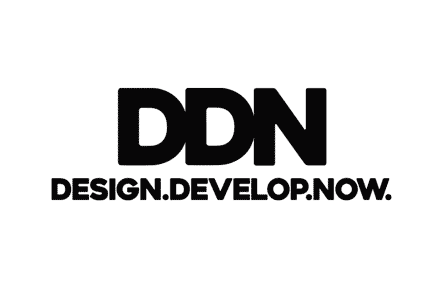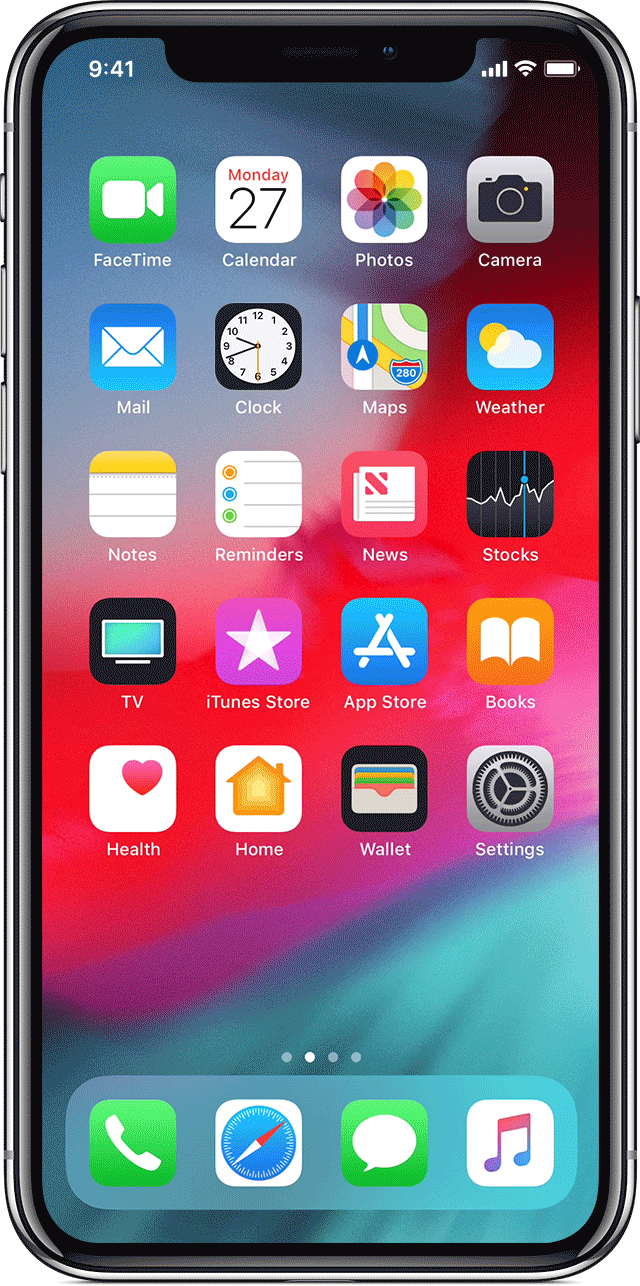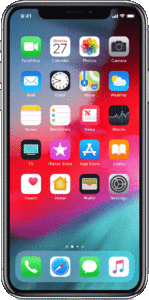How Much Does it Cost to Make an App?
A mobile app can cost anywhere between $10,000 – $250,000. You may have encountered numerous blogs discussing development costs for different application categories and complexity levels.
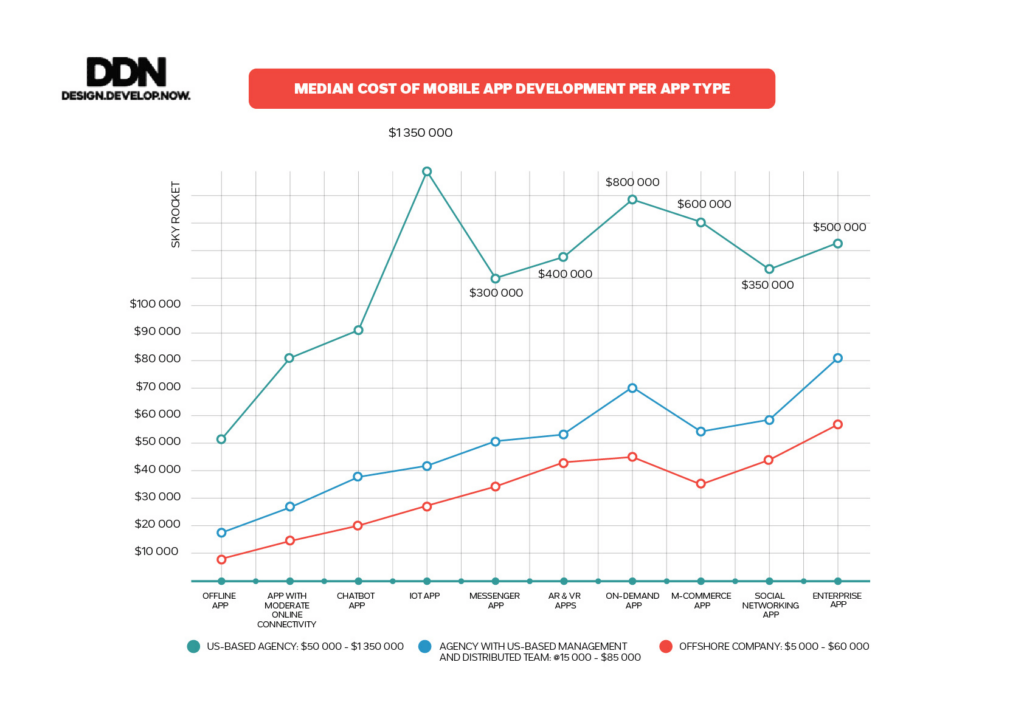
To provide some perspective and help you gain insights, we’ve prepared the following graphic, which presents standard costs for various types of applications. Additionally, we’ll address a crucial cost component – the development agency you choose to hire.

Although this might give you some perspective on the costing structure, it is still far from the actual story.
In reality the mobile application or for that matter any software development, no matter how much it has been commoditized, does not follow the general rules of pricing similar to tangible products.
If you have made it this far, we would urge you to read further to get a clear picture on the various aspects on which the cost of a mobile application depends. We strongly believe that cost, although is an important factor in degerming if you want to proceed with productizing your idea or not, is not the only critical factor that you should consider if you are thinking of building a successful product.
What does the Cost of App development depend on?
Let’s talk about the various components that contribute to the development cost of a mobile application.
Functional Scope
Functional scope is the most important contributor to cost of application development. To put this simply, a greater number of features = more cost. But wait, this is not always true, what we also need to consider is, how complex these features are to develop. An app with less but highly complex features can cost significantly higher than another app with more but less complex features. Now, since I have introduced the concept of complexity, let’s discuss it in detail in the next section.
Complexity
In the recent past, the applications were relatively simple & so were the demands of the users using them. Increased penetration of mobile phones, faster data speeds & cutthroat competition in the mobile apps space has given birth to a generation of users that are always looking for more. Moreover, the advent of new technologies like Machine Learning, Real-Time Analytics, Internet of Things, GIS, Instant-chat & 3D has further spiraled the complexity levels of the applications to another level. Also, since apps are now also handling sensitive user & financial data various regulations have also come into force in order to protect users from prying eyes of hackers. Therefore, while talking about complexity we need to look at the following aspects in order to determine the complexity level of the application & thereby the cost of development.
-
Functional complexity of the App – This is probably the simplest one. Some examples of functionally complex applications could be ones that deal with
-
Sensor integrations e.g. Home automation apps;
-
Series of business rules to arrive at a conclusion i.e. Recommendation engines that profile users
-
Multiple 3rd party integrations e.g. Aggregator services Trivago
-
Media processing e.g. YouTube
-
Real-time messaging e.g. WhatsApp
-
Push notifications
-
-
Design Complexity of the App – when we talk about the design complexity of an application, we are looking at the following
-
Number of distinct platforms on which the development is to be done. This not only includes the mobile operating systems like iOS & Android which have drastically different approach to User interactions but also includes optimization’s of applications for tablets & other handheld PC’s.
-
-
Regulatory compliance – This is probably the most underrated aspect of complexity but has the potential to significantly impact the cost of the app development. This primarily is the set of functional and non-functional features that have to be included in the app in order to ensure its compliance to various regulations within the area of operation e.g. GDRPR for user privacy & PCI-DSS compliance for financial data.
Technology Stack & Platforms
After understanding the various aspects that contribute to app costs with respect to scope & complexity, let’s now look at the impact of the development platform selection on the cost of the app. There are primarily 3 different options to choose from.
-
Native – These are mobile OS specific frameworks which only support development of applications for their respective OS e.g. Swift, Java & Kotlin.
-
Hybrid – These are cross platform application development frameworks that let developers work on single code base for all mobile OS e.g. React Native or Xamarin.
-
Rapid Application Development frameworks – These are third party frameworks that have pre-built components for various app features e.g. Kony, AppSheet, Bubble, Microsoft Power Apps, Siemens, Mendix and Salesforce Lightning.
The table below will give you an in-depth comparison across the above options that would help you determine which approach is suitable for your app concept.
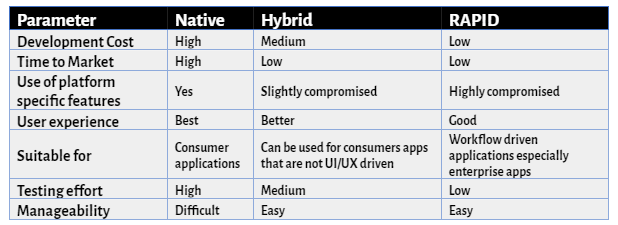
Branding & Copy writing
Branding is an integral component of a business model & therefore its cost must be considered while determining the overall development cost of the app. We strongly recommend that the copywriter & designers work closely to craft a brand story that the users relate to and also provides an unique identity to your brand. Moreover, a well-crafted creative copy elevates the user’s experience of the application making it more engaging and thereby increasing their interaction time with the app. Although this is an important aspect of the product marketing strategy, its cost can be kept nominal in the beginning.
Development Team / Partner
The last important point to consider in computing the App development cost is the team you intend to use for development. In the current scenario there are 3 very distinct choices in front of you
-
Build an in-house team by Hiring developers, project manager(s), architects & product managers
-
Hire an agency and outsource the application development partially or completely. In this case, you have a few options like.
-
Hiring local (US Based) agency
-
Working with a US based agency that has a development team offshore
-
Outsourcing the development to an offshore company
-
-
Work with freelancers to develop the application

While each of the above options have their advantages & disadvantages, we will not be discussing them in detail here. Instead, we will try to look at these options across some key impact areas with the help of the below matrix. We believe this will provide you with enough pointers to choose what’s right for your product.

Being a start-up, an app budget is always a constraint but quality & time to market is also important. This is where you must do a thorough analysis on the ROI based on the above pointers and finalize a partner/ team that suits you the best.
Hidden App development costs that you need to know
Now that we have already discussed the key factors that impact the cost of the app, it’s time to look at some of the other aspects that are worth considering even though they might not have a significant impact on app development costs.
Application hosting charges – This is the cost charged by the Apple App Store & Google play store to allow you to host your app on their platform.
Infrastructure costs – This is the cost of deployment of the application servers. This could either be on premise or using a cloud service like AWS, AZURE etc.
3rd Party integration costs & Licensing fees – These include the fees paid to any 3rd party service being used by an application e.g. Payment gateway charges, Fees for using Google Maps API etc.
Support and maintenance costs (updates, bug fixes, enhancements) – This is the additional cost (maintenance costs) that is incurred for ensuring smooth functioning & upkeep of the app. This cost comes into play post deployment.
Marketing & user acquisition costs – These are typically the costs incurred on the marketing, advertising activities in order to spread awareness about the app & acquire more users.
Checklist for successful product launch
Now that we have understood the components that contribute towards the development cost of an app, let’s have a look at some key aspects that play an important role in determining the success of an app.
Having the right product strategy
It all starts with the right product strategy. You might have a great app idea but it’s destined to fail if the market is not ready for it.
So how do you go about defining the product strategy? In subsequent sections we are going to touch upon some of the proven & widely recognized tools & frameworks that can be put to use.
Strategy definition
Let’s begin with some building blocks for your product strategy. First, you must establish the mission for the product. This is the highest-level objective/ purpose of the product that simply defines how your product will change the world for the better.
Before diving into our product strategy, it’s worth noting that sometimes the simplest ideas can lead to massive success. Take a moment to explore this article on Simple Apps That Made Millions. It’s a testament to the power of identifying unique value propositions. Next comes the overall product strategy itself: This is about finding something of value to your market that your competitors can’t or won’t deliver.
Finally, you should focus on a well-defined execution plan for the defined strategy.
Since this topic is vast enough to have an article of its own, let’s leave the details on strategy definition for another day. In the meantime, you can touch base with our team of experts at DDN should you wish to go through a formal process of defining the strategy for your product.
Let’s look at one of the simplest yet powerful frameworks for creating product strategy for start-ups i.e. The Lean Canvas but before jumping into it we need to understand the Lean start-up methodology that is being widely used by many start-ups to build successful business..
The concept of Lean Start-up
As the author of the famous book “The Lean Start-up” Eric Ries defines a start-up as an organization dedicated to creating something new under conditions of extreme uncertainty.
Let’s dig a bit deeper into his concept and understand what a lean start-up is.
Lean start-up is a methodology for developing businesses and products that aims to shorten product development cycles and rapidly discover if a proposed business model is viable; this is achieved by adopting a combination of business-hypothesis-driven experimentation, iterative product releases, and validated learning. Lean start-up emphasizes customer feedback over intuition and flexibility over planning. This methodology enables recovery from failures more often than traditional ways of product development. – Blank, Steve (May 2013). “Why the Lean Start-Up Changes Everything”. Harvard Business Review.
This concept assumes that start-ups can avoid huge financial disasters arising due to product failures by iteratively building products that cater to the needs of their early adopters. If they focus on eliminating waste and increasing value in their early phases, they have a better hance of success without requiring large amounts of outside funding, elaborate business plans, or a perfect product.
Remember – Iterative development, eliminating waste & focusing on activities that bring value are the key concepts highlighted above. We will understand how this is done when we introduce the concept of MVP in the subsequent sections.
Lean Canvas
Being a start-up/ Lean Start-up, you need a quicker way to get ideas out of your head into a tangible format so that you can communicate that with others. This is where the Lean Canvas comes into picture. It is an adaptation, by Ash Maurya, from the very popular Business Model Canvas by Alexander Osterwalder.
In principle it’s a one-page format that helps in brainstorming & capturing various aspects of your business idea in a simple & understandable format.

You can read more about the Lean canvas here: https://medium.com/@steve_mullen/an-introduction-to-lean-canvas-5c17c469d3e0
We know that we have just scratched the surface with the details shared above, but the idea of sharing this article is to give you a well-structured guide that you can use to build your product.
Let’s move to the next key aspect of a successful product launch. Scope definition and identifying your MVP – remember we talked about MVP in the section on Lean Start-up.
Scope & Roadmap Definition
Product scope is the set of well-defined characteristics/ features that address how a product works, how it is made & how it will evolve in future iterations.
In order to clearly define the scope & product roadmap you will have to go through a well-structured iterative process that starts with the “Discovery phase”. This is where the various aspects discussed during the Lean canvas are translated into functional requirements. During this phase we deep dive into the objectives, constraints, operating environment and try to zero down on the scope by thoroughly evaluating and balancing various factors like the Costs, market needs, competitive landscape, our capabilities, technical feasibility etc.

The Discovery phase may cover but is not restricted to the following activities that can be chosen as per the unique requirements of each product
-
Owner (your) interview
-
Ideation & scoping workshop
-
Competitor analysis
-
Market analysis & target market identification
-
User Interviews
Based on the above, the key outcomes of this phase are
-
Product requirement specifications
-
Technical competence requirements & constraints
-
High-level product roadmap
-
User personas
-
User journeys
An essential aspect of the Product scoping is identification of the MVP and defining the product roadmap. We are going to discuss the MVP in the next section.
What is MVP
A Minimum Viable Product (MVP) is a version of the final product that has enough features to attract early adopters thereby helping in getting the product idea/ concept validated early in the product development life cycle. As per Eric Ries, who introduced the MVP concept it is “It is the version of a new product that allows a team to collect the maximum amount of validated learning about customers with the least amount of effort.”

It’s important to ensure that the end product allows your customers to complete an entire task or project and provides a high-quality user experience. An MVP cannot be a user interface with many half-built tools and features. It must be a working product that your company should be able to sell. Viability is about delivering enough value to users.

Why do we need an MVP
Now that we have understood the concept of MVP, lets have a look at a few reasons for defining the MVP for your product.
-
Validation of product idea & core functionality
-
Tests market demand for custom features
-
Faster GTM
-
Acquisition of early adopters.
-
Save time and money on developing the final product.
-
Attract investors earlier.
What to consider while defining the MVP
Following are some of the key aspects that you should consider while identifying your MVP.
-
Clearly defined business goals
-
Prioritized set of business objectives
-
Purpose of the MVP
-
Success criteria for MVP
-
Target market & user base
-
Clearly defined user personas
-
Problems you want to solve or improvements you want to enable for your user persona.
-
Set of features that make up the scope of MVP: Ensure end to end flows are considered
Choosing the right Technology stack & target Platforms
So far, we have gone through details of defining the strategy & scope of the product. Now let’s get into the technical details of product development. The decision that you have to make here is to identify the right mobile platforms to target and choose the correct framework for development.
Target operating system
In order to choose the mobile platform that you need to develop for i.e. iOS, Android OR both, you can consider identifying the type of users in your target market. This is important as the target market or the end user type can play a significant role in deciding the platform/ OS that you need to target first. E.g. the penetration of android phones is higher in developing countries while iOS is higher in developed countries, so if your target market is developing countries it’s safer to go ahead with Android first approach. While this is not the only criteria, it’s a good starting point. This could be further broken down into the user category that is being targeted i.e. if the app is for working professionals in developed countries you can safely assume that iOS would be the OS of choice. Further the penetration of various versions of the operating systems in the target market can also be analyzed to aid decision making.

Another aspect that needs to be evaluated is the technology/ framework that should be used for development. Although a decision like this is best left to your technical partner, we can take you through a few important aspects that you can consider. Let’s first understand the available options – There are primarily 2 types of frameworks available – Native & Cross Platform.
Native app development refers to building a mobile app exclusively for a single platform using tools and language that is specific to that OS e.g. Java or Kotlin for Android & Swift or Objective-C for iOS apps.
Cross platform apps work on multiple platforms while still having a single code base. This is done by using tools like React Native, Xamarin, and Flutter, where the apps created can be deployed on both Android and iOS.
Native Or Cross-Platform
The following table gives a very high-level comparison of various pros & cons of Native & Cross platform applications. This will help you choose the right tech for your app.
Based on the above comparison we can conclude that Applications that have complex UI’s or require integration with mobile hardware are better off being developed in Native. Whereas, if you are tight on budgets or have aggressive time to market goals but can compromise on the performance & user experience, cross platform is the way to go.

Choosing the right development partner
Choice of the correct development partner also plays a critical role in the end-to-end journey of your product development lifecycle. A partner who is able to understand your product, guide you throughout the development lifecycle & is flexible enough to swiftly accommodate the changing requirements should be on top of your priority list. The choice of partner should not only be a commercial decision but should take into account a lot of factors, some of which are mentioned below:
Location & Setup – Location plays an important role in partner selection. Its always easier to work with a partner who is co-located as this avoids any unnecessary communication delays due to time zone difference. While it’s easier to work with a co-located partner, it can be a significantly expensive proposition as well. Therefore, we suggest that a partner who is co-located but has their development team in an offshore location can provide the advantages of both.
Portfolio – The next thing that should be paid attention to while choosing a partner is their experience in working on similar applications in the past. Client testimonials and work samples can be referred to, to establish their credibility.
Flexibility – Another important aspect is the flexibility of the partner in deploying resources across varying skill sets as per the needs of the project.
Responsibility – The partner should be able to provide for OR take end to end responsibility of the deliverables including
Product Strategy
Project Scoping
Application Development
Infrastructure setup & Application Deployment
Post development support/ Maintenance
Now, before you make your decision, you should be better equipped after reading this article. You should understand that determining the cost of app development involves considering various factors such as the functional scope, complexity, technology stack, branding, development team, app development budget, and hidden costs. However, cost to build should not be the only factor driving your decision-making process. Instead, focus on building a successful product by defining a solid product strategy, identifying your MVP, and choosing the right technology stack and development company.
Remember that app development is not a one-size-fits-all approach, and each project is unique. Therefore, it’s essential to conduct thorough research, understand your target audience, and work with a reliable and experienced development team to bring your app idea to life.
The app development process plays a crucial role in the success of your project. From ideation to deployment, a well-structured development process ensures that your app meets the desired quality standards and is delivered on time and within the app development budget.
If you’re considering app development in Eastern Europe, you may find competitive hourly rates and high-quality work from reputable development companies in the region. Cost of mobile app hosting and infrastructure should also be factored into your budget.
App maintenance costs and support are essential considerations post-launch. Ensuring timely updates, bug fixes, and enhancements will keep your app running smoothly and your users satisfied.
Branding and copywriting are integral to the success of your app. A well-crafted brand story and creative copy elevate the user experience, making your app more engaging and memorable.
Choosing the right development company is critical. Whether you decide to build an in-house team or outsource to an agency or freelancers, their expertise and flexibility will impact the quality and timely delivery of your app for both iOS and Android platforms.
In the end, marketing and user acquisition costs must not be overlooked. Spreading awareness about your app and acquiring users require a well-thought-out marketing strategy.
Now that you have a better understanding of the key factors influencing the cost of app development, including the app development budget, hourly rate, it’s time to take the next step and turn your app idea into a reality. Don’t let the complexities of app development deter you; with the right approach and development company, you can create a successful and innovative mobile app that meets your business objectives and delights your users. Contact us today or schedule a FREE CONSULTATION to discuss your app development goals.
